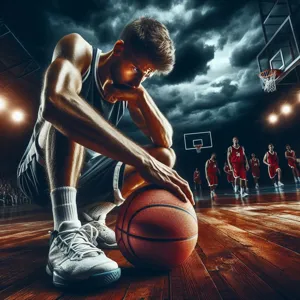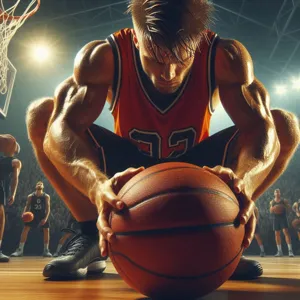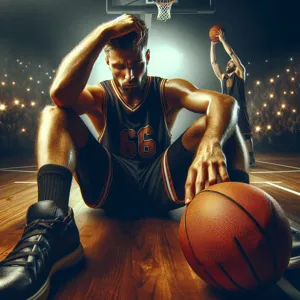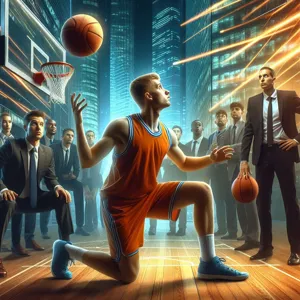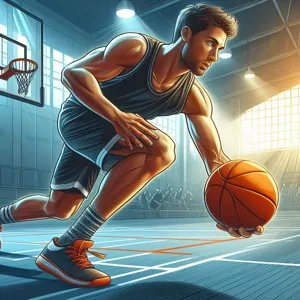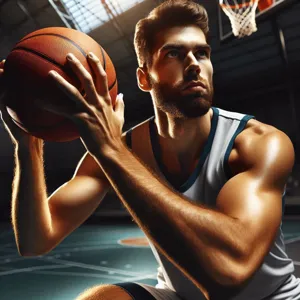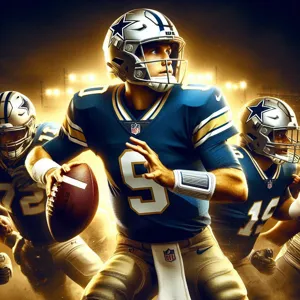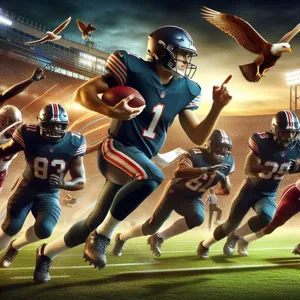Basketball is not just a game of skill and physical prowess; it’s a canvas for creativity where every dribble, pass, and shot can tell a unique story.
whether you’re a seasoned player looking to elevate your game or a budding athlete eager to explore your potential, unleashing your inner playmaker can transform your approach on the court. In this post, we’ll dive into tips and techniques that encourage innovative thinking, helping you break free from conventional playstyles and embrace your creativity. From mastering unconventional moves to developing a keen sense of spatial awareness, we’ll explore how to cultivate your basketball intuition and surprise both your teammates and opponents. Get ready to think outside the box and redefine the way you play, as we embark on a journey to unlock the creative playmaker within you!
1. Understanding the Role of a Playmaker in Basketball

To truly unleash your inner playmaker, it’s essential to first grasp the multifaceted role that playmakers occupy on the basketball court. A playmaker is not just a position; it’s a mindset that blends skill, intuition, and a deep understanding of the game. At its core, the playmaker is the orchestrator of the offense, the one who sets the tempo and creates opportunities for teammates. This requires a unique combination of vision, decision-making, and leadership.
A skilled playmaker possesses an innate ability to read the game as it unfolds. They have an acute awareness of their teammates’ strengths and weaknesses, allowing them to distribute the ball in a way that maximizes scoring chances. This level of court awareness goes beyond just knowing where everyone is positioned; it involves anticipating movements and understanding defensive schemes, almost like a chess master strategizing several moves ahead.
Moreover, playmakers are often tasked with breaking down defenses. With a keen sense of timing and a deft handle, they can penetrate the lane, draw defenders, and either kick the ball out for an open shot or finish at the rim themselves. This dual threat makes them invaluable assets to their teams, as they can adapt their play style to exploit any defensive weaknesses.
In addition to physical skills, emotional intelligence plays a significant role in a playmaker’s success. They must inspire confidence in their teammates, fostering an environment where everyone feels engaged and empowered to contribute. Whether it’s through vocal encouragement or by demonstrating unselfish play, the best playmakers elevate their entire team’s performance.
Embracing the role of a playmaker means embracing creativity. It’s about improvisation, thinking outside the box, and having the courage to try unconventional plays. Whether it’s a no-look pass, a behind-the-back dribble, or a daring drive to the basket, a true playmaker thrives on unpredictability and flair, making the game not just a sport, but an art form.
In sum, understanding the role of a playmaker involves recognizing the balance between skill, strategy, and emotional leadership. By internalizing these elements, you can start to cultivate your own playmaking abilities, setting the stage for not only personal growth but also for enhancing the performance of your team on the court.
2. The Importance of Creativity on the Court
Creativity on the basketball court is not just about making flashy plays or attempting jaw-dropping moves; it’s about the ability to adapt, innovate, and see the game through a unique lens. In a sport defined by structure and strategy, creativity serves as the catalyst that transforms a good player into a great one. When you embrace creativity, you unlock a world of possibilities that can give you an edge over your opponents.
Imagine a scenario where the game is on the line, and every player on the court is anticipating the same predictable plays. This is where your creativity can shine. By thinking outside the box, you can devise unexpected strategies or execute unconventional moves that catch your defenders off guard. This could be a no-look pass that sets up a teammate for an open shot, or a sudden change of direction that leaves your opponent scrambling. These moments of ingenuity not only elevate your gameplay but can also energize your team and inspire those around you.
Moreover, creativity fosters a deeper understanding of the game. It encourages you to analyze situations from various angles, considering not just the current play but how it fits within the larger context of the game. This mindset allows you to anticipate your opponents’ moves and react swiftly, whether it’s creating space for a shot or making that perfectly timed defensive stop.
Incorporating creativity into your practice routine can also lead to improvement on multiple levels. Whether you’re experimenting with new drills, working on unconventional shots, or collaborating with teammates to devise fresh plays, the process of exploration can enhance your skills and boost your confidence. Ultimately, embracing creativity on the court empowers you to express your individuality, making the game not only more enjoyable but also an exciting challenge that pushes you to grow as a player. So, the next time you step onto the hardwood, remember: unleash your imagination and let your creativity shine, because that’s where the magic of basketball truly happens.
3. Observing and Learning from Playmaking Legends

To truly unleash your inner playmaker, one of the most invaluable steps you can take is to observe and learn from the legends of the game. Basketball is an art form, and the greats have mastered their craft through years of dedication and innovation. By immersing yourself in the playing styles, decision-making processes, and creative techniques of renowned playmakers, you can expand your own understanding of the game and elevate your skills.
Start by watching game footage of legendary playmakers like Magic Johnson, Larry Bird, or modern-day maestros like LeBron James and Chris Paul. Pay close attention to their court vision—the way they anticipate plays before they unfold, their ability to read defenses, and their knack for delivering pinpoint passes in high-pressure situations. notice how they use fakes and body language to create space and opportunities, making the defense second-guess their movements.
But learning isn’t just about admiring their on-court brilliance; it’s also about dissecting their decision-making processes. Review critical moments in games where these players made game-changing assists or strategic plays. Consider what they saw at that moment, what options were available, and how they orchestrated their teammates to execute the play effectively.
Take this a step further by incorporating these observations into your own practice. Create drills that mimic the scenarios you’ve studied, focusing on the footwork, timing, and angles that the legends utilized. This hands-on experience will help you develop your instincts and improve your playmaking abilities.
Finally, don’t forget to analyze not just the successes but also the failures. Every playmaker has had their share of misreads and turnovers. Understanding what went wrong in those moments can be just as educational as studying their highlights. By recognizing the nuances of both triumph and error, you’ll gain a deeper appreciation for the creativity and resilience that defines a true playmaker.
By observing and learning from the legends, you’re not just watching basketball; you’re absorbing the very essence of playmaking. This process will empower you to think outside the box, push the boundaries of your creativity, and ultimately make your mark on the court.
4. Drills to Enhance Your Court Vision
Enhancing your court vision is one of the most critical aspects of becoming a playmaker in basketball. Court vision refers to your ability to see the entire playing area, anticipate plays, and make decisions that benefit your team. To elevate this skill, incorporating specific drills into your training routine can yield significant improvements.
**1. Three-Man Weave:** This classic drill not only enhances passing skills but also sharpens your ability to read the defense and anticipate movement. With three players forming a line, they weave in and out while passing the ball down the court. As you execute this drill, focus on your peripheral vision—keep your head up and scan the area for open teammates or defenders. This practice helps develop the instinct to make quick decisions in game situations.
**2. Spotting the Open Man:** Set up a shooting drill where you start at the top of the key. With a partner stationed at various spots on the court, practice passing to them while moving. Have them call for the ball at unexpected times, forcing you to react quickly and adjust your court awareness. This exercise cultivates your ability to find the open man under pressure—an essential skill for any playmaker.
**3. Blindfold Passing:** To truly stretch your court vision, enlist a teammate and a blindfold. With your eyes covered, have your partner call out directions and positions as you practice passing. This drill forces you to rely on your other senses and deepens your understanding of spatial awareness on the court. You’ll sharpen your instincts and become more adept at making plays without needing to see everything in your immediate field of vision.
**4. Scrimmage Situations:** Finally, nothing beats real-game experience. Engage in scrimmages where you focus solely on making the right play rather than scoring. Set specific goals, such as making a certain number of assists or creating scoring opportunities for teammates. By immersing yourself in game-like scenarios, you’ll develop a heightened awareness of player movements, defensive strategies, and the overall flow of the game.
As you incorporate these drills into your practice, remember that enhancing your court vision requires time and patience. With consistent effort, you’ll find yourself not just seeing the game, but truly understanding it—transforming you into the playmaker your team needs to thrive on the court.
5. Practicing Improv: Thinking on Your Feet

In the fast-paced world of basketball, the ability to think on your feet can be the difference between a good player and a great one. Practicing improv isn’t just about spontaneity; it’s about training your mind and body to react instinctively to the unfolding game around you. To enhance your creativity on the court, consider incorporating improvisational exercises into your routine.
Start by setting up small scrimmages with friends where the rules are flexible. Instead of following a strict playbook, challenge yourself to adapt to the flow of the game. For instance, allow each player to call their own plays or create scenarios where you can only pass in specific ways or use unconventional movements. This fosters an environment where you’re encouraged to think outside the box and explore new strategies.
Another effective method is to visualize different game situations during your practice sessions. As you dribble down the court, imagine various defensive setups and consider how you might respond creatively. Perhaps you see an opening for a no-look pass or a spin move that wasn’t part of your original plan. The key is to embrace uncertainty and be willing to experiment with your skills.
Moreover, you can enhance your improvisational skills through drills that involve rapid decision-making. For example, engage in one-on-one matchups where your opponent can change their approach at any moment. This will require you to react swiftly and creatively, forcing your brain to process information quickly and come up with solutions in real-time.
Ultimately, practicing improv will not only improve your individual performance but also enhance your ability to collaborate with teammates. Basketball is a team sport, and the best plays often come from a shared understanding of each other’s instincts. By honing your improvisational skills, you’ll become a more versatile player who can adapt to various situations, keeping both your opponents and teammates on their toes. Embrace the unpredictability of the game, and watch your creativity flourish on the court!
6. Developing a Unique Playing Style
Developing a unique playing style is one of the most exciting aspects of the game of basketball. It’s about more than just mastering the fundamentals; it’s about finding a way to express your personality on the court. Your playing style is the visual representation of your skills, instincts, and creativity, and it can set you apart in a sea of players all vying for the same glory.
To forge your unique style, start by examining the players you admire. Do you gravitate towards the flashy ball-handling of a streetball legend, or do you prefer the precision of a sharpshooter? Take note of their movements, decision-making, and how they leverage their strengths. However, while it’s beneficial to draw inspiration from others, resist the urge to mimic them completely. Instead, incorporate elements you admire into your game while allowing your natural instincts to shine through.
Next, experiment with different aspects of your game—try out various shooting techniques, dribbling styles, and defensive maneuvers. Don’t be afraid to take risks during practice sessions; this is where you’ll discover what feels natural and what doesn’t. Engage in drills that challenge you to think outside the box, such as improvisational play exercises where you create your own moves on the fly. This not only enhances your skill set but also builds your confidence to express your individuality during games.
Another key component of developing a unique playing style is understanding your body and what it can do. Are you quick and agile, making you a slasher who thrives on weaving through defenders? Or are you taller and more powerful, allowing you to dominate in the post? Recognizing your physical attributes will help you tailor your game to maximize your strengths and minimize your weaknesses.
Lastly, embrace the process of self-discovery. Your playing style will evolve as you gain experience, so remain open to change and growth. As you refine your skills and deepen your understanding of the game, you’ll find that your unique style emerges organically, reflecting your journey as a player. Remember, basketball is as much a personal expression as it is a sport—so unleash your creativity and let your playing style tell your story on the court.
7. Incorporating Unconventional Moves in Your Game

In the world of basketball, creativity can set you apart from the competition, and one of the most effective ways to elevate your game is by incorporating unconventional moves. These unexpected maneuvers can catch defenders off guard, open up passing lanes, and create scoring opportunities that might not exist through traditional techniques.
Picture this: you’re dribbling down the court, and as you approach a defender, instead of relying solely on the standard cross-over or behind-the-back dribble, you execute a slick spin move followed by a step-back jumper. This combination not only surprises your opponent but also showcases your versatility as a player.
Moves like the Eurostep, floater, or even the infamous “Hesi” (hesitation dribble) can add flair and unpredictability to your offensive arsenal. Practicing these unconventional techniques during drills allows you to develop muscle memory, making it second nature to pull them off during a game. And don’t shy away from experimenting with other sports’ moves, like the no-look pass popularized in streetball or the fake-out dribble often seen in soccer.
Additionally, think about your positioning on the court. Sometimes, simply changing where you catch the ball can open up new possibilities. Try receiving passes from unusual angles or utilize off-ball screens to create mismatches. This not only enhances your gameplay but also keeps defenders guessing, which is key to breaking down their defensive schemes.
Ultimately, embracing unconventional moves is about having the confidence to express yourself on the court. So, step outside your comfort zone, allow your imagination to flourish, and watch as your basketball creativity transforms you into a true playmaker. With practice and determination, you’ll not only elevate your game but also inspire your teammates to embrace their own unique styles.
8. The Power of Visualization Techniques
Visualization techniques are powerful tools that can unlock your creative potential on the basketball court. The mind is a formidable player, often underestimated in its ability to influence performance. By harnessing the art of visualization, you can mentally rehearse your moves, anticipate opponents’ actions, and cultivate a sharper instinct for the game.
Start by finding a quiet space where you can focus, free from distractions. Close your eyes and picture yourself in a game scenario. Visualize every detail: the sound of the ball bouncing, the feel of the court beneath your feet, the expressions on your teammates’ faces, and the intensity of the crowd. Envision yourself executing a perfect crossover dribble, driving to the basket, and sinking a smooth jump shot. The more vividly you imagine these moments, the more your brain begins to adapt to them.
Research shows that visualizing success not only enhances your confidence but also improves muscle memory. As you mentally practice, your brain creates neural pathways that translate into physical skills on the court. This is particularly useful for developing complex plays or mastering new techniques. Whether you’re working on your shooting form or perfecting your defensive stance, visualization can help you break down each element, allowing you to see the game from different angles and develop innovative strategies.
Moreover, visualization isn’t just about individual plays; it can also encompass team dynamics. Picture yourself communicating effectively with your teammates, setting screens, and making those crucial assists. By visualizing a cohesive team unit, you can foster a sense of synergy that translates into real game scenarios.
Incorporating visualization into your training routine is simple. Spend a few minutes each day dedicated to this practice, and over time, you’ll notice a significant boost in your creativity and decision-making on the court. Embrace the power of visualization, and watch as your inner playmaker emerges, ready to take your game to exhilarating new heights.
9. Building Chemistry with Teammates
Building chemistry with teammates is akin to orchestrating a symphony on the basketball court; it requires harmony, understanding, and trust. When players are in sync, they can anticipate each other’s moves, creating a fluidity that transforms the game from a mere contest of skill into an art form. To cultivate this chemistry, start by investing time in off-court bonding. Engage in team-building activities that foster communication and camaraderie. Whether it’s sharing meals, participating in community events, or simply hanging out, these moments lay the groundwork for deeper connections.
On the court, focus on developing non-verbal communication. Work on establishing signals, eye contact, and body language cues that convey intentions without the need for words. Practice drills that emphasize teamwork, such as passing sequences and pick-and-roll scenarios, where players learn to read each other’s movements and adapt accordingly. Encourage open dialogue during practice sessions, allowing teammates to share insights and feedback. This collaborative environment nurtures creativity, as players feel more comfortable experimenting with innovative plays when they know their teammates will have their backs.
Moreover, embrace the power of shared experiences. Celebrate victories together and analyze losses collectively, ensuring that every moment contributes to a stronger bond. When teammates understand each other’s strengths and weaknesses, they can leverage this knowledge to create unexpected plays and strategies. In essence, building chemistry is not just about playing well together; it’s about cultivating a shared vision that inspires each player to unleash their inner creativity, turning the basketball court into a canvas for teamwork and innovation.
10. Analyzing Game Film for Creative Insights
Analyzing game film is a crucial yet often overlooked aspect of enhancing your basketball creativity. Watching footage of your own games, as well as those of others, provides a treasure trove of insights that can elevate your understanding of the game. When you sit down to dissect the plays, you’re not just observing the actions on the court; you’re diving deep into the strategies, movements, and decision-making processes that define effective gameplay.
Start by reviewing your own performance—look for moments where you hesitated or made a less-than-ideal choice. Ask yourself why you did what you did: Was it a lack of confidence in your shooting, or were you simply unaware of your teammates’ positioning? Pay attention to how successful plays unfolded, focusing on the creativity and adaptability of the players involved. Notice how they read the defense, made quick decisions, or executed unexpected moves that caught opponents off guard.
Don’t limit your analysis to your own games; study professionals and their unique styles. Observe how they create space, use fakes, or set up their teammates for easy baskets. Pay attention to the little details—the way they communicate, their body language, and how they exploit defensive weaknesses. By incorporating these creative insights into your practice sessions, you can develop a more comprehensive skill set that allows you to improvise during games.
As you watch, take notes on concepts or plays that resonate with you. Experiment with these ideas in your drills, adapting them to your playing style and incorporating them into your game. This process not only enhances your basketball IQ but also fosters an environment where creativity flourishes. The more you analyze, the more you’ll find inspiration, allowing you to unleash your inner playmaker and transform your game on the court.
11. Staying Mentally Flexible in High-Pressure Situations
Staying mentally flexible in high-pressure situations is crucial for unleashing your inner playmaker on the basketball court. The intensity of a close game can create an overwhelming atmosphere, where the stakes feel higher with each passing moment. It’s precisely during these times that your ability to adapt and think creatively becomes your greatest asset.
To cultivate mental flexibility, practice mindfulness techniques that help you stay present and focused amidst chaos. Visualization exercises can also be beneficial; imagine yourself navigating through various scenarios on the court—whether it’s making a split-second decision to drive to the basket or dishing out a no-look pass to an open teammate. By rehearsing these moments in your mind, you prepare yourself to respond intuitively when the pressure mounts.
Additionally, embracing a growth mindset can enhance your resilience. Understand that mistakes are part of the game, and instead of dwelling on errors, view them as opportunities to learn and improve. When you approach high-pressure situations with this mindset, you’ll be more likely to experiment with creative plays rather than defaulting to familiar, safer options.
Engage in drills that simulate high-pressure conditions, like timed scrimmages or competitive shooting sessions. These scenarios can help train your brain to remain calm and think clearly when the game is on the line. Remember, the best playmakers are those who can maintain their composure, adapt to the unexpected, and turn pressure into opportunity. By developing your mental flexibility, you’ll not only enhance your own performance but also inspire your teammates to elevate their game alongside you.
12. Overcoming the Fear of Making Mistakes
Overcoming the fear of making mistakes is one of the most liberating steps you can take as a basketball player looking to unleash your creativity on the court. Fear can be paralyzing, often leading players to stick to what’s comfortable and familiar rather than experimenting with new moves or plays. But remember, even the greatest players in history—think Michael Jordan or LeBron James—aren’t immune to errors; they simply embrace them as part of the learning process.
To break through this barrier, start by reframing your mindset. Instead of viewing mistakes as failures, see them as valuable opportunities for growth. Each time you miss a shot or make a wrong pass, ask yourself what you can learn from the experience. Did you rush your decision? Was your footwork off? Reflecting on these moments can help you identify patterns in your gameplay that need improvement.
Another effective strategy is to create a low-pressure environment where you can practice new skills without the fear of judgment. Whether it’s a casual pick-up game with friends or solo drills at the local gym, allow yourself the freedom to try out that behind-the-back pass or that flashy spin move. The more you practice these techniques, the more comfortable you will become, and gradually, your fear of failure will dissipate.
Additionally, seek feedback from coaches or more experienced players who can provide constructive criticism. Instead of focusing solely on what went wrong, ask them to highlight what you did well and how you can build on those strengths. This positive reinforcement can help shift your focus away from fear and towards creativity.
Finally, remember that basketball is a game, meant to be played and enjoyed. Embrace a playful attitude and let go of the pressure to be perfect. When you do, you’ll find that your creativity flourishes, and you’ll start making bold decisions on the court that not only enhance your game but also inspire those around you. After all, in basketball, as in life, the most memorable moments often come from taking a leap of faith—mistakes and all.
13. Embracing Playfulness in Practice
Embracing playfulness in practice is the secret ingredient that can elevate your basketball creativity to new heights. Often, training can become a monotonous grind of drills and routines, where the joy of the game starts to fade. Yet, it’s during these playful moments that true innovation flourishes.
Imagine transforming your standard shooting drills into a friendly competition with teammates or friends. Instead of simply taking shots from the same spot, why not add a twist? Set up a game of “HORSE” or create obstacle courses where you must navigate through cones before making the shot. Incorporating fun elements like music or quirky challenges can unleash a sense of enjoyment that ignites your passion for the game.
Playfulness can also extend to your approach to tactics. Experiment with unconventional strategies during scrimmages—try out different positions or explore new plays that may initially seem outlandish. Allowing yourself to think outside the box not only keeps practice engaging but also encourages a mindset where mistakes become valuable learning experiences rather than setbacks.
Moreover, don’t shy away from incorporating elements of other sports or activities into your training. Whether it’s footwork drills inspired by dance or agility exercises borrowed from soccer, blending various skills can enhance your overall athleticism and creativity on the court.
By embracing playfulness in practice, you cultivate an environment where exploration and spontaneity thrive. This not only enhances your skills but also fosters a deeper connection to the game, allowing you to unleash your inner playmaker and surprise both yourself and your opponents with your creative flair on the basketball court.
14. Setting Personal Challenges to Stimulate Creativity
Setting personal challenges is a powerful way to ignite your basketball creativity and take your game to the next level. By pushing yourself beyond your comfort zone, you create opportunities to think differently and explore innovative approaches on the court.
Start by identifying specific skills you want to improve—be it dribbling, shooting, or passing—and then design challenges that encourage you to experiment. For instance, set a goal to complete a series of dribble moves in a limited time frame, or challenge yourself to make a certain number of shots from increasingly difficult spots on the court. You might create a game for yourself where every time you score, you have to add an additional dribble move before shooting, forcing you to think creatively under pressure.
Consider incorporating variations into your practice routine. Instead of simply running through drills, introduce constraints that require you to adapt. For example, practice shooting with your non-dominant hand, or try dribbling while navigating through an obstacle course. These challenges not only enhance your physical skills but also stimulate your mind, encouraging you to envision plays and scenarios that you may not typically consider.
Moreover, invite your teammates to join in on these challenges. Engaging in friendly competitions can foster an environment of creativity and innovation. You might create a mini-tournament where each player has to showcase their most creative shot or play. This not only keeps the spirit of competition alive but also inspires everyone to think outside the box, ultimately resulting in a more dynamic and creative team play.
Remember, the key is to keep it fun and engaging. Setting personal challenges should invigorate your love for the game, allowing you to express yourself creatively while developing your skills. Embrace the process, and watch as your newfound creativity transforms your performance on the court.
15. Creating a Supportive Environment for Self-Expression in Basketball
Creating a supportive environment for self-expression in basketball is crucial for unlocking your inner playmaker. The court is not just a place for competition; it’s a canvas for creativity where players can explore their unique styles and instincts. To foster this environment, start by encouraging open communication among teammates. Promote a culture where players feel comfortable sharing ideas, experimenting with new moves, and even making mistakes without fear of judgment. When everyone understands that self-expression is valued, it cultivates confidence and innovation on the court.
Coaching also plays a significant role in creating this supportive atmosphere. Coaches should embrace diverse playing styles and encourage players to showcase their individual strengths. Rather than enforcing a strict playbook, allow room for improvisation and creativity. Celebrate those moments when a player tries something new, even if it doesn’t lead to immediate success. Highlighting creativity can inspire others to take risks and develop their own unique flair.
Moreover, fostering a sense of community off the court can reinforce this supportive environment. Organize team-building activities that allow players to bond and express themselves in casual settings. Whether it’s a game of pickup basketball, a creative skills workshop, or even a team outing, these experiences can strengthen relationships and open up channels of communication.
Finally, be mindful of the language used during practice and games. Positive reinforcement and constructive feedback can go a long way in encouraging players to express themselves. Acknowledging creativity in play, even in small ways, may lead to a more liberated and imaginative style of basketball that could elevate the entire team’s performance. By creating a space that values self-expression, you’ll not only enhance your own creativity but also inspire your teammates to unleash their inner playmakers on the court.
As we wrap up our exploration of unleashing your inner playmaker, remember that creativity on the basketball court is about more than just flashy moves—it’s about finding your unique style and expressing yourself through the game. By incorporating the tips we’ve shared, from honing your fundamental skills to embracing improvisation, you can elevate your game and make a lasting impact in every play. Don’t be afraid to experiment and take risks; some of the most memorable moments in basketball come from those daring, creative instincts. So, grab your ball, hit the court, and let your imagination flow! We can’t wait to see how you transform your game and inspire others with your newfound creativity.





